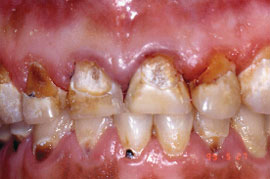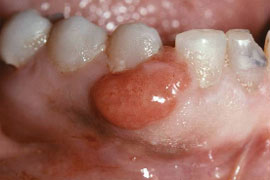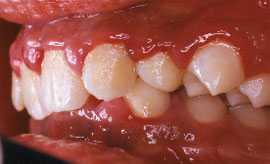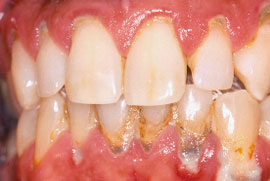
Am Fam Physician. 2008;77(8):1139-1144
Author disclosure: Nothing to disclose.
Oral health care in pregnancy is often avoided and misunderstood by physicians, dentists, and patients. Evidence-based practice guidelines are still being developed. Research suggests that some prenatal oral conditions may have adverse consequences for the child. Periodontitis is associated with preterm birth and low birth weight, and high levels of cariogenic bacteria in mothers can lead to increased dental caries in the infant. Other oral lesions, such as gingivitis and pregnancy tumors, are benign and require only reassurance and monitoring. Every pregnant woman should be screened for oral risks, counseled on proper oral hygiene, and referred for dental treatment when necessary. Dental procedures such as diagnostic radiography, periodontal treatment, restorations, and extractions are safe and are best performed during the second trimester. Xylitol and chlorhexidine may be used as adjuvant therapy for high-risk mothers in the early postpartum period to reduce transmission of cariogenic bacteria to their infants. Appropriate dental care and prevention during pregnancy may reduce poor prenatal outcomes and decrease infant caries.
Comprehensive prenatal health care should include an assessment of oral health, but this is often overlooked.1 Only 22 to 34 percent of women in the United States consult a dentist during pregnancy. Even when an oral problem occurs, only one half of pregnant women attend to it.2 This problem is compounded by a lack of national clinical guidelines for the management of common oral conditions in pregnancy. The American Dental Association and the American College of Obstetricians and Gynecologists provide only advisory brochures on oral health for pregnant patients. New York recently became the first state to create an evidence-based prenatal oral health consensus document.3 In the absence of practice guidelines, fear of medicolegal action based on negligent or substandard treatment of oral conditions during pregnancy abounds, but it is largely unfounded.4
| Clinical recommendation | Evidenc e rating | References | Comments |
|---|---|---|---|
| Periodontitis may be associated with preterm birth and low birth weight. | B | 19 | Recommendation from nine case-control studies, two cross-sectional studies, seven cohort studies, two RCTs, and two meta-analyses |
| Preliminary evidence suggests that deep root scaling in pregnant women with periodontitis may help prevent preterm birth and low birth weight. | B | 20–22 | Consistent findings in two small RCTs21,22; one RCT found no relationship20 |
| Use of oral topical antibacterial treatment of dental caries in mothers in late pregnancy and/or the postpartum period can lower maternal oral bacterial load and reduce transmission of bacteria to infants. | B | 26, 27 | Consistent findings for xylitol and chlorhexidine (Peridex) in two small RCTs |
In addition to a lack of practice standards, barriers to dental care during pregnancy include inadequate dental insurance, persistent myths about the effects of pregnancy on dental health, and concerns for fetal safety during dental treatment.5 Patients, physicians, and dentists are cautious, often avoiding treatment of oral health issues during pregnancy.
Nevertheless, pregnancy is a time when women may be more motivated to make healthy changes.3 Physicians can address maternal oral issues, potentially reducing the risk of preterm birth and childhood caries through oral disease prevention, diagnosis, early management, and dental referral.
Common Oral Problems in Pregnancy
ORAL LESIONS
During pregnancy, the oral cavity is exposed more often to gastric acid that can erode dental enamel. Morning sickness is a common cause early in pregnancy; later, a lax esophageal sphincter and upward pressure from the gravid uterus can cause or exacerbate acid reflux. Patients with hyperemesis gravidarum can have enamel erosions.6 Management strategies aim to reduce oral acid exposure through dietary and lifestyle changes, plus the use of antiemetics, antacids, or both. Rinsing the mouth with a teaspoon of baking soda in a cup of water after vomiting can neutralize acid.3 Pregnant women should be advised to avoid brushing their teeth immediately after vomiting and to use a toothbrush with soft bristles when they do brush to reduce the risk of enamel damage. Fluoride mouthwash can protect eroded or sensitive teeth.7
CARIES
One fourth of women of reproductive age have dental caries, a disease in which dietary carbohydrate is fermented by oral bacteria into acid that demineralizes enamel8 (Figure 1). Pregnant women are at higher risk of tooth decay for several reasons, including increased acidity in the oral cavity, sugary dietary cravings, and limited attention to oral health.9 Early caries appears as white, demineralized areas that later break down into brownish cavitations. Fillings or crowns are a sign of previous caries. Untreated dental caries can lead to oral abscess and facial cellulitis. Children of mothers who have high caries levels are more likely to get caries.10 Pregnant patients should decrease their risk of caries by brushing twice daily with a fluoride toothpaste and limiting sugary foods. Patients with untreated caries and associated complications should be referred to a dentist for definitive treatment.

PREGNANCY ORAL TUMOR
Pregnancy oral tumor (Figure 2) occurs in up to 5 percent of pregnancies and is indistinguishable from pyogenic granuloma. This vascular lesion is caused by increased progesterone in combination with local irritants and bacteria. Lesions are typically erythematous, smooth, and lobulated; they are located primarily on the gingiva. The tongue, palate, or buccal mucosa may also be involved. Pregnancy tumors are most common after the first trimester, grow rapidly, and typically recede after delivery. Management is usually observational unless the tumors bleed, interfere with mastication, or do not resolve after delivery. Lesions surgically removed during pregnancy are likely to recur.11

LOOSE (MOBILE) TEETH
Teeth can loosen during pregnancy, even in the absence of gum disease, because of increased levels of progesterone and estrogen affecting the periodontium (i.e., the ligaments and bone that support the teeth).12 For uncomplicated loose teeth not associated with periodontal disease (see below), physicians should reassure patients that the condition is temporary, and alone it will not cause tooth loss.
GINGIVITIS
Gingivitis (Figure 3) is the most common oral disease in pregnancy, with a prevalence of 60 to 75 percent.6 Approximately one half of women with preexisting gingivitis have significant exacerbation during pregnancy.9 Gingivitis is inflammation of the superficial gum tissue. During pregnancy, gingivitis is aggravated by fluctuations in estrogen and progesterone levels in combination with changes in oral flora and a decreased immune response. Thorough oral hygiene measures, including tooth brushing and flossing, are recommended. Patients with severe gingivitis may require professional cleaning and need to use mouth rinses such as chlorhexidine (Peridex).

PERIODONTITIS
Periodontitis is a destructive inflammation of the periodontium (Figure 4) affecting approximately 30 percent of women of child-bearing age.3 The process involves bacterial infiltration of the periodontium. Toxins produced by the bacteria stimulate a chronic inflammatory response, and the periodontium is broken down and destroyed, creating pockets that become infected. Eventually, the teeth loosen.13 This process can induce recurrent bacteremia, which indirectly triggers the hepatic acute phase response, resulting in production of cytokines, prostaglandins (i.e., PGE2), and interleukins (i.e., IL-6, IL-8), all of which can affect pregnancy.14 Elevated levels of these inflammatory markers have been found in the amniotic fluid of women with periodontitis and preterm birth compared with healthy control patients.15 In one study, researchers found minimal oral bacteria in the amniotic fluid and placenta of women with preterm labor and periodontitis.16 It seems probable that this inflammatory cascade alone prematurely initiates labor. The mechanism is thought to be similar for low birth weight; the release of PGE2 restricts placental blood flow and causes placental necrosis and resultant intrauterine growth restriction.17

Periodontitis and Poor Pregnancy Outcomes
Periodontitis has been associated with several poor pregnancy outcomes, although the mechanism by which this occurs remains unclear and controversy exists. Preterm birth is the leading cause of neonatal morbidity in the United States, costing approximately $26.2 billion per year.18 Studying the direct effect of any risk factor on the outcomes of preterm birth and low birth weight is extremely difficult because of the many confounding variables that may affect the same outcome.
In a recent systematic review of mainly cross-sectional, case-control, and cohort studies conducted between 1996 and 2006 in 12 countries and three states, investigators identified 24 studies demonstrating a positive relationship between periodontitis and preterm birth, low birth weight, or both.19 These studies involved approximately 15,000 mothers. Three of the studies were randomized controlled trials (RCTs). Conversely, 14 studies reported no relationship between periodontitis and poor pregnancy outcomes. A recent, large, U.S.-based RCT found no association between periodontitis and preterm birth and low birth weight.20
Some of the study authors have postulated that racial differences in how periodontitis affects pregnancy outcomes may explain many of the varying results. Studies that involved more black patients had participants with more periodontal-related preterm labor. Another possible explanation is that treating periodontitis during pregnancy is too late to achieve a positive result. The focus should be on improving the condition before pregnancy.
The management of periodontitis in pregnancy is based on early diagnosis and deep root scaling. The authors of one RCT demonstrated that deep root scaling reduced the risk of birth before 37 weeks' gestation (preterm birth), with a risk reduction of 0.5 (confidence interval [CI], 0.2 to 1.3). For birth before 35 weeks' gestation (very preterm birth), the risk reduction was 0.2 (CI, 0.02 to 1.4) for women with periodontitis.21 In another RCT of deep root scaling combined with patient education, regular plaque removal, and routine chlorhexidine rinses, researchers also noted a reduction in the incidence of preterm low birth weight (risk reduction, 0.18; CI, 0.05 to 0.6).22 These studies, in addition to a recent U.S.-based RCT that found no benefit of treatment,20 reported no harm to the mother or fetus from treatment of maternal periodontal conditions.
Women with preexisting periodontal disease can reduce the risk of recurrence or worsening disease during pregnancy through proper oral hygiene. The American Academy of Periodontology recommends that all women who are pregnant or planning to become pregnant undergo a periodontal examination and any necessary treatment.23
Dental Care During Pregnancy
SCREENING AND PREVENTION
Every pregnant woman should be assessed for dental hygiene habits, access to fluoridated water, oral problems (e.g., caries, gingivitis), and access to dental care. Oral examination should include the teeth, gums, tongue, palate, and mucosa. Patients should be counseled to perform routine brushing and flossing, to avoid excessive amounts of sugary snacks and drinks, and to consult a dentist. Status of and plans for oral health should be documented. Many dentists are reported to be reluctant to treat pregnant women.24 Physicians and dentists can overcome this situation through education, clear communication, and the development of ongoing collaborative relationships. Physicians can share information on the safety of dental treatment in pregnancy with dental colleagues and provide clear referral recommendations.
CARIES RISK REDUCTION IN CHILDREN
Xylitol and chlorhexidine lower maternal oral bacterial load and reduce transmission of bacteria to infants when used late in pregnancy and/or in the postpartum period. Both topical agents are safe in pregnancy (U.S. Food and Drug Administration [FDA] pregnancy category B) and during breastfeeding.25–27 Studies have used different dosing levels, and the optimal dose for consistent prevention is unclear.
DIAGNOSIS
Dental radiography may be performed in pregnancy for acute diagnostic purposes.28,29 When possible, radiography should be delayed until after the first trimester. Screening radiography should be deferred until after delivery. Modern fast film, avoidance of retakes, and use of lead aprons and thyroid shields all limit risk. The teratogenic risk of radiation exposure from oral films is 1,000 times less than the natural risk of spontaneous abortion or malformation.24
ROUTINE DENTAL TREATMENT
Ideally, dental procedures should be scheduled during the second trimester of pregnancy when organogenesis is complete. Urgent dental care can be performed at any gestational age.23 The third trimester presents the additional problems of positional discomfort and the risk of vena caval compression. Propping a woman on her left side, repositioning often, and keeping visits brief can reduce problems.5 Deferring dental care until after delivery can be problematic because new mothers are focused on the care of their newborn and may have dental insurance only during pregnancy.14
MEDICATIONS FOR DENTAL PROCEDURES
Local anesthetics such as lidocaine (Xylocaine; FDA pregnancy category B) and prilocaine (Citanest; FDA pregnancy category B) mixed with epinephrine (FDA pregnancy category C) are safe for procedures when dosed appropriately.30 Sedatives such as benzodiazepines (e.g., midazolam [Versed; FDA pregnancy category D], lorazepam [Ativan; FDA pregnancy category D], triazolam [Halcion; FDA pregnancy category X]) should be avoided. Nitrous oxide is not rated and its use in pregnancy is controversial.31
MANAGEMENT OF ACUTE DENTAL CONDITIONS
If mild cellulitis is present, penicillin, amoxicillin, and cephalexin (Keflex; all FDA pregnancy category B) are reasonable first-line antibiotics. Erythromycin base (not erythromycin estolate, which is associated with cholestatic hepatitis in pregnancy) or clindamycin (Cleocin; both FDA pregnancy category B) can be used in the type 1 hypersensitivity penicillin–allergic patient. For severe cellulitis, the patient should be hospitalized and treated with intravenous cephalosporins or clindamycin. To manage dental pain, acetaminophen (FDA pregnancy category B), ibuprofen (Motrin; FDA pregnancy category B in the first and second trimesters, category D in the third trimester), and limited use of oxycodone (Roxicodone; FDA pregnancy category B in the first and second trimesters, category D in the third trimester) are appropriate depending on the gestational stage.